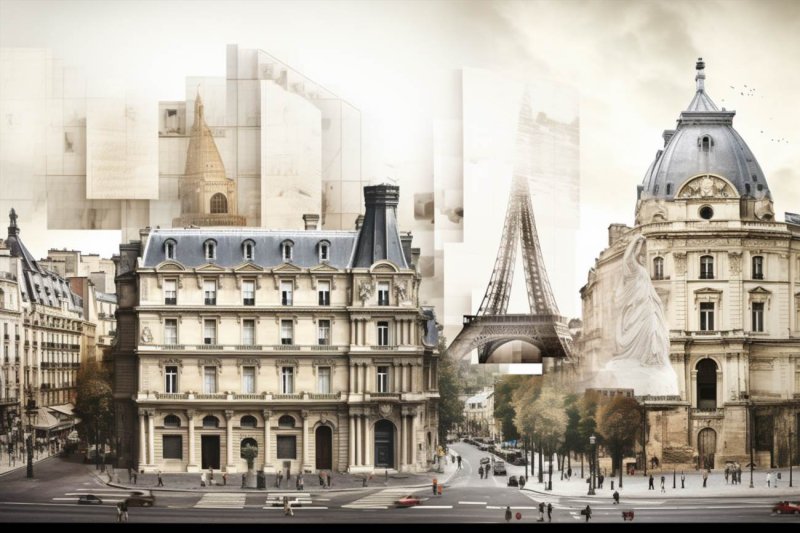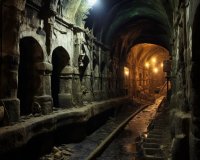A Brief History of Paris Architecture: From Catacombs to Modern Marvels

A Brief History of Paris’s Architecture: From Catacombs to Modern Marvels
Paris, the City of Lights, is renowned not only for its romantic ambiance, exquisite cuisine, and artistic heritage but also for its remarkable architecture that spans centuries. From the mysterious catacombs beneath the streets to the towering modern marvels, Paris's architectural journey is a fascinating tale of evolution and innovation.
The story begins deep below the surface, where the catacombs of Paris wind through a labyrinth of tunnels and chambers. Originally limestone quarries, these catacombs were transformed in the 18th century to house the remains of millions, creating a macabre yet intriguing underground world.
Emerging from the depths, Paris showcases a stunning array of Gothic architecture. The Notre-Dame Cathedral, an iconic masterpiece, stands as a testament to the medieval craftsmanship of the 12th century. Its intricate gargoyles and magnificent rose windows have inspired generations of architects and artists.
Transitioning into the Renaissance period, Paris saw the construction of the Louvre Palace. Originally built as a fortress, it later became a royal residence and eventually the world-famous Louvre Museum. The palace's elegant facade and grand courtyards reflect the opulence of the Renaissance era.
As the city entered the 19th century, the Haussmannian renovation project transformed Paris into a modern metropolis. Baron Haussmann's vision led to the creation of wide boulevards, ornate street lamps, and uniform building facades. This urban redesign not only enhanced the city's aesthetics but also improved sanitation and public mobility.
The late 19th and early 20th centuries marked the Belle Époque, a period of artistic flourishing and architectural innovation. The Eiffel Tower, an engineering marvel designed by Gustave Eiffel, became the symbol of this era. Its iron lattice structure challenged conventional architectural norms and captured the world's imagination.
Paris's architectural landscape continued to evolve in the 20th century with the emergence of Art Nouveau and Art Deco styles. The Castel Béranger, designed by Hector Guimard, exemplifies the organic forms and decorative elements of Art Nouveau, while the Palais de Chaillot showcases the geometric shapes and bold symmetry of Art Deco.
Post-World War II, Paris experienced a surge in modernist architecture. The UNESCO Headquarters, designed by Marcel Breuer, exemplifies the functionalist approach of the mid-20th century. Its simple yet striking design represents a departure from ornate embellishments, emphasizing form and utility.
Today, Paris continues to embrace architectural innovation with structures like La Défense, a business district featuring skyscrapers and contemporary designs. The Fondation Louis Vuitton, designed by Frank Gehry, is a testament to Paris's commitment to pushing architectural boundaries, featuring fluid lines and unconventional shapes.
In conclusion, Paris's architecture is a captivating narrative that unfolds through time, reflecting the city's rich history, cultural influences, and artistic aspirations. From the depths of the catacombs to the heights of modern skyscrapers, Paris stands as a living testament to the evolution of architectural styles and techniques.
Paris Catacombs Skip-the-Line Guided Tour and Special Access
Discover the chambers below the streets of Paris and learn the secrets of the world’s largest underground burial site on a skip-the-line guided tour of the Paris Catacombs. Access areas not available to the general public.
Highlights
- Descend 20 meters below the streets to explore the Paris Catacombs
- Skip the lines and get special access to forbidden areas
- Learn why the remains of over 6 million people were transported underground in the 18th century
- Immerse yourself in the history of legendary struggles and triumphs
Full Description
Meet your guide at the Paris Catacombs and skip the lines to descend 20 meters below street level. Learn how 200 miles of tunnels were mined to solve the problem of the overcrowded cemeteries, and hear about the struggle and ultimate glory of the macabre, sacred site.
Get a feel for the amazing chambers as you pass the "Arrete. C'est Ici L'Empire De La Mort" ("Stop. Here is the Empire of Death") sign. Find yourself surrounded by bones and skulls, carefully arranged with reverence and a decorative flourish.
Enter special areas closed to the general public as you follow in the footsteps of the 18th and 19th-century French royals.
Includes
- Skip-the-line entry ticket to the Paris Catacombs
- VIP access to areas not available to the general public
- English-speaking guide
Meeting Point
From Metro station Denfert Rochereau (line 4 or 6), use Exit 1 to reach the street level. You’ll see the Catacombs entrance, with glass doors and a sign, across the street, located to the right of the small green building that was the former entrance. Your guide will be waiting with an orange "ExperienceFirst" sign.
Important Information
- What to bring: Comfortable shoes
- Not allowed: Pets, Smoking, Luggage or large bags
This tour includes an approximately 1-mile walk, with about 130 steps down and 85 steps back up to street level. It is not recommended for people who have mobility issues or suffer from anxiety in closed spaces. Please note that the temperature in the catacombs is around 14 degrees Celsius.
If the selected time is not available you will be offered options to reschedule. If you are unable to accept a reschedule option you will be offered a full refund.
The Mysterious Catacombs of Paris
Deep beneath the bustling streets of Paris, there lies a vast network of tunnels and chambers, known as the Paris Catacombs. This subterranean world has become one of the city's most iconic and enigmatic attractions. A visit to the Catacombs offers a haunting journey through history, art, and the boundaries between life and death.
History of the Catacombs
The Catacombs of Paris, also known as "les Catacombes," date back to the 18th century. Originally, they were limestone quarries used for building the city. However, by the late 18th century, many of the city's cemeteries were overcrowded, leading to improper burials and spreading diseases.
In response to this crisis, in 1786, the city officials made the decision to transfer the remains from Parisian cemeteries into these old quarries. The process lasted for decades and resulted in the creation of the Catacombs as they are known today.
The Design and Structure
The Catacombs stretch over 200 miles, although only a small portion is open to the public. The tunnels are meticulously arranged, with the bones of the deceased forming elaborate walls and patterns. The careful placement of skulls and femurs creates a morbid artistry, showcasing the respect and reverence with which these remains were treated.
The Inscriptions
Throughout the Catacombs, visitors will find various inscriptions that offer reflections on life, death, and the passage of time. One such inscription reads: "Stop! Here lies the Empire of Death." These poetic phrases enhance the contemplative atmosphere of the Catacombs and provoke introspection among those who traverse its paths.
Legends and Stories
Like any historical place shrouded in darkness, the Catacombs are not without their legends. There are tales of people getting lost and never emerging, spirits haunting the tunnels, and secret societies holding meetings in hidden chambers.
Visiting the Catacombs
| Opening Hours |
Entry Fee |
Guided Tours |
| 10:00 am - 8:00 pm |
€14 for adults |
Available in multiple languages |
Note: Always check the official website before visiting, as the timings and fees may change.
Conclusion
The Catacombs of Paris offer a unique perspective on the city's history and the universal human experience. A visit here is not just a tourist attraction; it's a profound encounter with the past and a stark reminder of our own mortality. Those who venture into these shadowy depths emerge with a deeper appreciation for the brevity of life and the mysteries of the hereafter.
Skip-the-Line: Paris Catacombs Guided Tour with VIP Access
Discover the haunting underground labyrinth of the Paris Catacombs with exclusive VIP access. Your expert guide will lead you through this unique attraction, revealing its dark secrets and rich history.
Highlights
- Explore the Paris Catacombs and discover their dark secrets
- Learn the history and legends of the Catacombs from an expert guide
- Skip the lines waiting to enter this unique Paris attraction
Paris, often celebrated for its beauty and romance, holds a secret beneath its iconic landmarks. Deep below the city streets lies the Catacombs, a realm of death and history. With limited access for only 200 visitors at a time, long lines and waits of up to 2 hours are common. However, with our VIP access, you'll save time and make the most of this personalized visit.
Stretching for nearly 300 kilometers beneath Paris, the Catacombs originated as limestone quarries, essential for constructing the city's famous structures. From the 18th century onwards, they became the resting place for over 6 million souls, their bones neatly lining the walls and arches.
Join our exclusive small-group tour and see Paris from a perspective unlike any other.
Includes
- English-speaking expert guide
- Entrance ticket and reservation fee for the Paris Catacombs
Not included:
- Hotel pick-up and drop off
- Food and drinks
- Gratuities (optional)
Not suitable for
- People with mobility impairments
- People with claustrophobia
- Wheelchair users
Meeting Point
Meet outside the catacombs by Denfert Rochereau. Look for your guide in a blue polo shirt or jacket, holding a sign for easy identification. If you're taking the Metro, use line 4 or line 6 to reach the Denfert-Rochereau stop and exit at Sortie 1. The catacombs' entrance is directly across the street.
Important:/
What to bring: Comfortable shoes, Jacket
Modern Architectural Gems in Paris
Paris, often referred to as the "City of Light," is not only celebrated for its rich history and romantic ambiance but also for its stunning architectural wonders. While the city is steeped in history, it's also a hotbed of modern architectural innovation. In this article, we'll explore some of the modern architectural gems that grace the streets of Paris.
1. The Louis Vuitton Foundation
The Louis Vuitton Foundation, designed by renowned architect Frank Gehry, is a true masterpiece of contemporary architecture. This striking building resembles a sailboat with its billowing glass sails and organic forms. It's nestled in the lush greenery of the Bois de Boulogne and serves as both an art museum and a cultural center.
The foundation's design is a harmonious blend of glass and steel, allowing natural light to flood the exhibition spaces. Its innovative construction techniques and fluid design have made it an iconic symbol of modern Parisian architecture.
2. Philharmonie de Paris
The Philharmonie de Paris, designed by architect Jean Nouvel, is a testament to modernity and sophistication. This concert hall, located in the Parc de la Villette, boasts a futuristic design with its metallic façade that seems to be draped like a shimmering silver robe.
Inside, the concert hall features impeccable acoustics and a visually stunning auditorium with undulating balconies. It's a venue where music and architecture come together in perfect harmony, making it a must-visit for both music enthusiasts and architecture aficionados.
3. Fondation d'Entreprise Louis Vuitton
Another architectural jewel by Frank Gehry in Paris is the Fondation d'Entreprise Louis Vuitton. This contemporary art museum is a symphony of glass panels and curved forms that appear to defy gravity. Gehry's innovative use of glass and steel creates a sense of transparency and lightness, making the building seem almost weightless.
The Fondation d'Entreprise Louis Vuitton is not only a cultural hub but also a visual delight. Its intricate design showcases the endless possibilities of modern architecture in a city steeped in tradition.
4. Paris Philharmonic Hall
The Paris Philharmonic Hall, located in the Parc de la Villette, is another architectural marvel by Jean Nouvel. It's a radical departure from traditional concert hall design, featuring a futuristic aesthetic characterized by its bold use of materials and shapes.
The façade of the Philharmonic Hall is a shimmering interplay of aluminum and glass, while its interior offers a sense of grandeur and innovation. It's a testament to how modern architecture can breathe new life into the cultural institutions of a historic city.
5. The Shard Paris
The Shard Paris, designed by architect Renzo Piano, is a towering skyscraper that has reshaped the city's skyline. This glass-clad structure rises majestically along the Seine River and offers panoramic views of the city from its observation deck.
The Shard Paris is a prime example of contemporary urban architecture, featuring a sleek and sustainable design. Its energy-efficient features and iconic presence make it a symbol of modernity in the heart of Paris.
In conclusion, while Paris is celebrated for its historic landmarks and timeless beauty, it's also a city at the forefront of modern architectural innovation. The buildings mentioned above are just a glimpse of the modern gems that contribute to the city's architectural tapestry. Paris continues to evolve, embracing modernity while cherishing its rich heritage.






